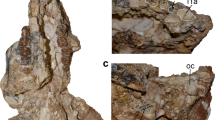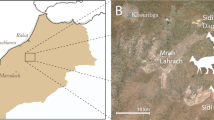Abstract
Dog-like marsupials (superfamily Borhyaenoidea) were the largest predacious mammals during the Tertiary period in South America1. They are critical to our understanding of marsupial origin, phylogeny and palaeobiogeography because they have been related to various marsupial lineages of several continents: didelphoids2 (mainly New World, but also Europe, Asia and Africa), pediomyid3, stagodontids4 (North America), dasyuroids5 (Australia) and deltatheroidans6 (predominantly Asian). These relationships, based mainly on dental morphology, have been discussed and rejected several times2,3,7,8. Here we report the discovery of exceptionally well preserved skulls and skeletons, referrable to the didelphoid Andinodelphys, which shed new light on the phylogenetic and palaeobiogeographic origin of dog-like marsupials. The skulls of Mayulestes (boryhyaenoid)9, Andinodelphys and Pucadelphys (didelphoids)10,11 from the early Palaeocene epoch of Bolivia are the oldest known for American marsupials. Comparison of their basicranial anatomy suggests that dog-like marsupials are closely related to an early didelphimorphian radiation in South America, rather than to Asiatic (deltatheroidan), North American (stagodontid), or Australian (dasyuroid) lineages.
This is a preview of subscription content, access via your institution
Access options
Subscribe to this journal
Receive 51 print issues and online access
$199.00 per year
only $3.90 per issue
Buy this article
- Purchase on Springer Link
- Instant access to full article PDF
Prices may be subject to local taxes which are calculated during checkout






Similar content being viewed by others
References
Marshall, L. G. Evolution of the Borhyaenidae, extinct south American predaceous marsupials. Univ. Calif. Pub. Geol. Sci. 117, 1–89 (1978).
Archer, M. in Carnivorous Marsupials (ed. Archer, M.) 397–443 (Royal Society of New South Wales, Sydney, (1982)).
Marshall, L. G. Cladistic analysis of borhyaenoid, dasyuroid, didelphoid, and thylacinid (Marsupialia, Mammalia) affinity. Syst. Zool. 26, 410–425 (1977).
Marshall, L. G., Case, J. A. & Woodburne, M. O. in Current Mammalogy (ed. Genoways, H. H.) 343–505 (Plenum, New York, (1990)).
Archer, M. The dasyurid dentition and its relationships to that of didelphids, thylacinids, borhyaenids (Marsupiacarnivora) and peramelids (Peramelina, Marsupialia). Aust. J. Zool.(suppl.) 39, 1–34 (1976).
Marshall, L. G. & Kielan-Jaworrowska, Z. Relationships of the dog-like marsupials, deltatheroidans, and early tribosphenic mammals. Lethaia 25, 361–374 (1992).
Fox, R. C. Ancestry of the “dog-like” marsupials. J. Paleontol. 53, 733–735 (1979).
Fox, R. C. & Naylor, B. G. in Sixth Symp. Mesozoic Terrestrial Ecosystem Biota (eds San, A. & Wang, Y.) 247–250 (China Ocean, Beijing, (1995)).
Muizon, C. d Anew carnivorous marsupial from the early Palaeocene of Bolivia and the problem of marsupial monophyly. Nature 370, 208–211 (1994).
Marshall, L. G. & Muizon, C. d Mém. Mus. Natl Hist. Nat. 165, 21–90 (1995).
Marshall, L. G. & Muizon, C. d The dawn of the age of mammals in South America. Natl Geogr. Res. 4, 23–55 (1988).
Muizon, C. d Mayulestes ferox, a borhyaenoid (Metatheria, Mammalia) from the early Palaeocene of Bolivia. Phylogenetic and Palaeobiologic implications. Géodiversitas (in the press).
Muizon, C. d Rev. Técn. Yac. Petrol. Fisc. Boliv. 12, 393–433 (1992).
Cifelli, R. L. Cretaceous mammals from southern Utah. I. Marsupials from the Kaiparowits Formation (Judithian). J. Vert. Paleontol. 10, 295–319 (1990).
Cifelli, R. L. Early Cretaceous mammal from North America and the evolution of marsupial dental characters. Proc. Natl Acad. Sci. USA 90, 9413–9416 (1993).
Cifelli, R. L. in Mammal Phylogeny (eds Szalay, F. S., Novacek, M. J. & McKenna, M. C.) 205–215 (Springer, New York, (1993)).
Szalay, F. S. Evolutionary History of the Marsupials and an Analysis of Osteological Characters (Cambridge Univ. Press, (1994)).
Clemens, W. A. Fossil mammals of the type Lance Formation, Wyoming. Part II. Marsupialia. Univ. Calif. Publ. Geol. Sci. 62, 1–122 (1966).
Matthew, W. D. Amarsupial from the Belly River Cretaceous. With critical observations upon the affinities of the Cretaceous mammals. Bull. Am. Mus. Nat. Hist. 35, 447–500 (1916).
Hoffstetter, R. Données et hypothèses concernant l'origine et l'histoire biogéographique des marsupiaux C.r. Acad. Sci. 274, 2635–2638 (1972).
Marshall, L. G. in Aspects of Vertebrate Evolution (ed. Jacobs, L. L.) 345–386 (Museum of Northern Arizona Press, Flagstaff, (1980)).
Cifelli, R. L. & Muizon, C. d Dentition and Jaw of Kokopellia juddi, a primitive marsupial or near-marsupial from the medial Cretaceous of Utah. J. Mamm. Evol. (in the press).
Clemens, W. A. & Lillegraven, J. A. New Late Cretaceous North American advanced therians that fit neither the marsupial nor the therian molds. Contrib. Geol. Spec. Pap. 3, 55–85 (1986).
Szalay, F. S. & Trofimov, B. The Mongolian Late Cretaceous Asiatherium, and the early phylogeny and paleobiogeography of Metatheria. J. Vert. Paleontol. 16, 474–509 (1996).
Fox. R. C. in Possums and Opossums (ed. Archer, M. 161–169 (Surrey Beatty/Royal Society of New South Wales, Sydney, (1987)).
Muizon, C. d & Brito, I. Le bassin calcaire de São José de Itaboraí (Rio de Janeiro, Brésil): ses relations avec le site de Tiupampa (Cochabamba, Bolivie). Ann. Paleontol. 79, 233–269 (1993).
Simpson, G. G. Splendid Isolation. The Curious History of South American Mammals (Yale Univ. Press, New Haven, CT, (1980)).
Bonaparte, J. New Late Cretaceous mammals from the Los Alamitos Formation, northern Patagonia. Natl Geogr. Res. 6, 63–94 (1990).
Cifelli, R. L. & Muizon, C. d Marsupial mammals from the upper Cretaceous North Horn Formation, central Utah. J. Paleontol. (in the press).
Aplin, K. P. & Archer, M. in Possums and Opossums (ed. Archer, M.) XV–LXXII (Surrey Beatty/Royal Society of New South Wales, Sydney, (1987)).
Acknowledgements
We thank R. Suarez Soruco for logistic support; M. Archer, Z. Luo and M. Woodburne for comments; F. Pilar for Fig. 2; H. Lavina for Fig. 3; and D. Serrette for photography. This work was funded by the Institut Français d'Études Andines (Lima, Peru), the URA 12 of the Centre National de la Recherche Scientifique (Paris, France), and by the Muséum National d'Histoire naturelle (Paris, France).
Author information
Authors and Affiliations
Rights and permissions
About this article
Cite this article
de Muizon, C., Cifelli, R. & Paz, R. The origin of the dog-like borhyaenoid marsupials of South America. Nature 389, 486–489 (1997). https://doi.org/10.1038/39029
Received:
Accepted:
Issue Date:
DOI: https://doi.org/10.1038/39029
This article is cited by
-
On the development of the chondrocranium and the histological anatomy of the head in perinatal stages of marsupial mammals
Zoological Letters (2017)
-
The Skull of Epidolops ameghinoi from the Early Eocene Itaboraí Fauna, Southeastern Brazil, and the Affinities of the Extinct Marsupialiform Order Polydolopimorphia
Journal of Mammalian Evolution (2017)
-
All About Current and Fossil Neotropical Mammals: 100 Million Years of Evolution Under the Tropics
Journal of Mammalian Evolution (2014)
-
Earliest evidence of mammalian social behaviour in the basal Tertiary of Bolivia
Nature (2011)
-
“South American” Marsupials from the Late Cretaceous of North America and the Origin of Marsupial Cohorts
Journal of Mammalian Evolution (2005)
Comments
By submitting a comment you agree to abide by our Terms and Community Guidelines. If you find something abusive or that does not comply with our terms or guidelines please flag it as inappropriate.



